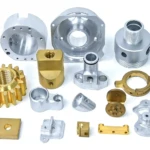The Importance of Using Modern Suspension Points in Industrial Settings
In today’s industrial environments, safety is paramount. With the constant need to lift, move, and transport heavy payloads, manual manipulation is often no longer sufficient, and the use of a lifting point becomes essential. While a simple lifting combination consisting of a DIN 580 lifting ring, chain, or metal rope may seem sufficient, hidden dangers can lurk in the shadows. In this blog post, we will explore the importance of using modern suspension points in industrial settings and highlight the risks associated with outdated methods.
Danger lurks in the shadows: The importance of modern suspension points
When an operator must lift, return, and transport heavy payloads, a lifting point is crucial to facilitate the process. Unfortunately, many manufacturers overlook the significance of this crucial component, leading to a higher risk of accidents and injuries. The DIN 580 lifting ring, in particular, can be a ticking time bomb. When used at a 90-degree angle, its load capacity is significantly reduced, making it a hazardous choice.
Figure 2 illustrates the limitations of traditional suspension points, which often lack modern standards. These systems do not provide sufficient security, safety factors, or flexibility, making it impossible for a single person to complete the installation process. The risks associated with using these points are substantial, as they can lead to accidents, injuries, and even fatalities.
Furthermore, Figure 3, 4, and 5 demonstrate the common use of suspension points during the production process, installation, and transportation of heavy payloads. These systems are subject to wear and tear, making them prone to failure, which can have devastating consequences.
The Growing Need for Modern Suspension Points
The safety and reliability of modern suspension points are no longer optional; they are a necessity. To achieve high resistance operations in industrial settings, manufacturers must adopt a proactive approach to safety. The "solution" can be found in Figure 8, which showcases the universal suspension point PP-S. This modern design meets the critical requirements for lifting, allowing for safe and efficient transportation of heavy payloads.
Key Features of Modern Suspension Points:
- Hook Will Not Fall: The PP-series ensures that the hook will not fall from the point suspended inadvertently, guaranteeing maximum safety.
- Safety Factor: The safety factor in both directions is 4, providing enhanced protection against accidents.
- Clearly Marked Charging Ratings: Clear labeling ensures easy identification of load-bearing capacities, reducing the risk of errors.
- Color-Coded: The units are color-coded to guarantee easy identification and categorization.
- Universal Connection: The PP-series allows for seamless connection with various lifting products, such as hooks, rings, and round straps.
- Free Rotation: The suspension point provides free rotation under full load, ensuring smooth operation and minimal wear and tear.
- No Damage to Points: The design prevents damage to the points suspended and heavy objects during reversal or displacement.
- Low Maintenance: The maintenance of the suspended point is minimal, reducing downtime and costs.
- Weldable: The PP-series can be welded in tight spaces without preheating, facilitating on-site repairs and maintenance.
In Conclusion, the safe and reliable use of suspension points is paramount in industrial settings. By choosing modern suspension points, manufacturers can ensure the highest level of safety, efficiency, and productivity. In contrast, outdated methods can lead to accidents, injuries, and fatalities. It is essential to rethink the role of suspension points in the production process and opt for innovative solutions. The PP-series from Luther, for instance, has been developed to meet the demanding needs of the industry, providing a long list of benefits, including advanced safety, flexibility, and maintenance-friendly design.
Why Choose Modern Suspension Points?
- Cost Savings: Modern suspension points can help reduce costs by minimizing the need for additional components and maintenance.
- Increased Productivity: The efficient transport and handling of heavy payloads can be achieved using modern suspension points.
- Enhanced Safety: Modern suspension points provide an additional layer of security, reducing the risk of accidents and injuries.
- Flexibility: The use of modern suspension points allows for quick and easy connection with various lifting products.
Conclusion
In conclusion, the importance of modern suspension points in industrial settings cannot be overstated. As the industry continues to evolve, it is crucial that manufacturers prioritize the use of innovative solutions that guarantee safety, efficiency, and reliability. The PP-series from Luther is an excellent example of this, offering a range of benefits that can revolutionize the way we approach lifting and transportation in industrial settings. Simplify your operations, reduce costs, and enhance safety with modern suspension points. The time to make the change is now.

















